COPD: Diagnosis, Treatment, and Research: A Comprehensive Analysis
VerifiedAdded on 2023/06/05
|8
|2519
|140
Report
AI Summary
This report provides a comprehensive overview of Chronic Obstructive Pulmonary Disease (COPD), encompassing its diagnosis, treatment, and current research. The diagnostic process is detailed, emphasizing the role of spirometry, particularly the FEV1/FVC ratio, and the identification of clinical symptoms such as chronic cough and dyspnea. Ancillary tests, including chest X-rays and bronchodilator reversibility testing, are also discussed. Treatment strategies encompass both pharmacotherapeutic interventions, such as bronchodilators, glucocorticoids, and antibiotics, and non-pharmacological approaches, including breathing interventions, pulmonary rehabilitation, and smoking cessation programs. The report further analyzes three key studies. The first study utilizes mechanomyographic (MMG) analysis to assess respiratory muscle function in COPD patients, correlating muscle activity with disease severity. The second study employs MMG to evaluate the relationship between incremental pressure and respiratory muscle effort. The third study uses electromyography (EMG) of the sternomastoid muscle to assess muscle activity and its correlation with COPD severity. The report synthesizes these findings, highlighting the significance of MMG and EMG in COPD diagnosis and management, and the importance of comprehensive therapeutic approaches.
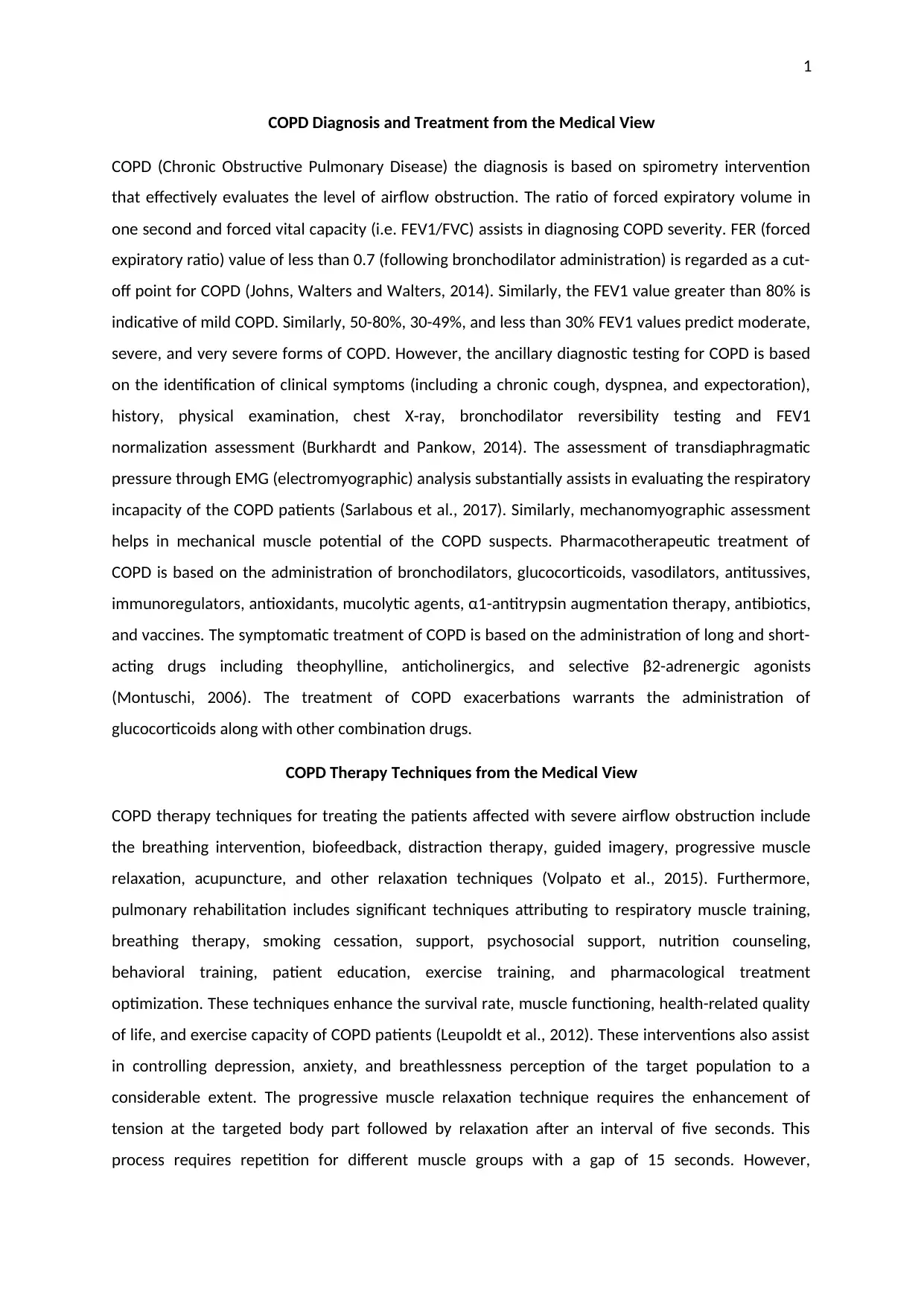
1
COPD Diagnosis and Treatment from the Medical View
COPD (Chronic Obstructive Pulmonary Disease) the diagnosis is based on spirometry intervention
that effectively evaluates the level of airflow obstruction. The ratio of forced expiratory volume in
one second and forced vital capacity (i.e. FEV1/FVC) assists in diagnosing COPD severity. FER (forced
expiratory ratio) value of less than 0.7 (following bronchodilator administration) is regarded as a cut-
off point for COPD (Johns, Walters and Walters, 2014). Similarly, the FEV1 value greater than 80% is
indicative of mild COPD. Similarly, 50-80%, 30-49%, and less than 30% FEV1 values predict moderate,
severe, and very severe forms of COPD. However, the ancillary diagnostic testing for COPD is based
on the identification of clinical symptoms (including a chronic cough, dyspnea, and expectoration),
history, physical examination, chest X-ray, bronchodilator reversibility testing and FEV1
normalization assessment (Burkhardt and Pankow, 2014). The assessment of transdiaphragmatic
pressure through EMG (electromyographic) analysis substantially assists in evaluating the respiratory
incapacity of the COPD patients (Sarlabous et al., 2017). Similarly, mechanomyographic assessment
helps in mechanical muscle potential of the COPD suspects. Pharmacotherapeutic treatment of
COPD is based on the administration of bronchodilators, glucocorticoids, vasodilators, antitussives,
immunoregulators, antioxidants, mucolytic agents, α1-antitrypsin augmentation therapy, antibiotics,
and vaccines. The symptomatic treatment of COPD is based on the administration of long and short-
acting drugs including theophylline, anticholinergics, and selective β2-adrenergic agonists
(Montuschi, 2006). The treatment of COPD exacerbations warrants the administration of
glucocorticoids along with other combination drugs.
COPD Therapy Techniques from the Medical View
COPD therapy techniques for treating the patients affected with severe airflow obstruction include
the breathing intervention, biofeedback, distraction therapy, guided imagery, progressive muscle
relaxation, acupuncture, and other relaxation techniques (Volpato et al., 2015). Furthermore,
pulmonary rehabilitation includes significant techniques attributing to respiratory muscle training,
breathing therapy, smoking cessation, support, psychosocial support, nutrition counseling,
behavioral training, patient education, exercise training, and pharmacological treatment
optimization. These techniques enhance the survival rate, muscle functioning, health-related quality
of life, and exercise capacity of COPD patients (Leupoldt et al., 2012). These interventions also assist
in controlling depression, anxiety, and breathlessness perception of the target population to a
considerable extent. The progressive muscle relaxation technique requires the enhancement of
tension at the targeted body part followed by relaxation after an interval of five seconds. This
process requires repetition for different muscle groups with a gap of 15 seconds. However,
COPD Diagnosis and Treatment from the Medical View
COPD (Chronic Obstructive Pulmonary Disease) the diagnosis is based on spirometry intervention
that effectively evaluates the level of airflow obstruction. The ratio of forced expiratory volume in
one second and forced vital capacity (i.e. FEV1/FVC) assists in diagnosing COPD severity. FER (forced
expiratory ratio) value of less than 0.7 (following bronchodilator administration) is regarded as a cut-
off point for COPD (Johns, Walters and Walters, 2014). Similarly, the FEV1 value greater than 80% is
indicative of mild COPD. Similarly, 50-80%, 30-49%, and less than 30% FEV1 values predict moderate,
severe, and very severe forms of COPD. However, the ancillary diagnostic testing for COPD is based
on the identification of clinical symptoms (including a chronic cough, dyspnea, and expectoration),
history, physical examination, chest X-ray, bronchodilator reversibility testing and FEV1
normalization assessment (Burkhardt and Pankow, 2014). The assessment of transdiaphragmatic
pressure through EMG (electromyographic) analysis substantially assists in evaluating the respiratory
incapacity of the COPD patients (Sarlabous et al., 2017). Similarly, mechanomyographic assessment
helps in mechanical muscle potential of the COPD suspects. Pharmacotherapeutic treatment of
COPD is based on the administration of bronchodilators, glucocorticoids, vasodilators, antitussives,
immunoregulators, antioxidants, mucolytic agents, α1-antitrypsin augmentation therapy, antibiotics,
and vaccines. The symptomatic treatment of COPD is based on the administration of long and short-
acting drugs including theophylline, anticholinergics, and selective β2-adrenergic agonists
(Montuschi, 2006). The treatment of COPD exacerbations warrants the administration of
glucocorticoids along with other combination drugs.
COPD Therapy Techniques from the Medical View
COPD therapy techniques for treating the patients affected with severe airflow obstruction include
the breathing intervention, biofeedback, distraction therapy, guided imagery, progressive muscle
relaxation, acupuncture, and other relaxation techniques (Volpato et al., 2015). Furthermore,
pulmonary rehabilitation includes significant techniques attributing to respiratory muscle training,
breathing therapy, smoking cessation, support, psychosocial support, nutrition counseling,
behavioral training, patient education, exercise training, and pharmacological treatment
optimization. These techniques enhance the survival rate, muscle functioning, health-related quality
of life, and exercise capacity of COPD patients (Leupoldt et al., 2012). These interventions also assist
in controlling depression, anxiety, and breathlessness perception of the target population to a
considerable extent. The progressive muscle relaxation technique requires the enhancement of
tension at the targeted body part followed by relaxation after an interval of five seconds. This
process requires repetition for different muscle groups with a gap of 15 seconds. However,
Paraphrase This Document
Need a fresh take? Get an instant paraphrase of this document with our AI Paraphraser
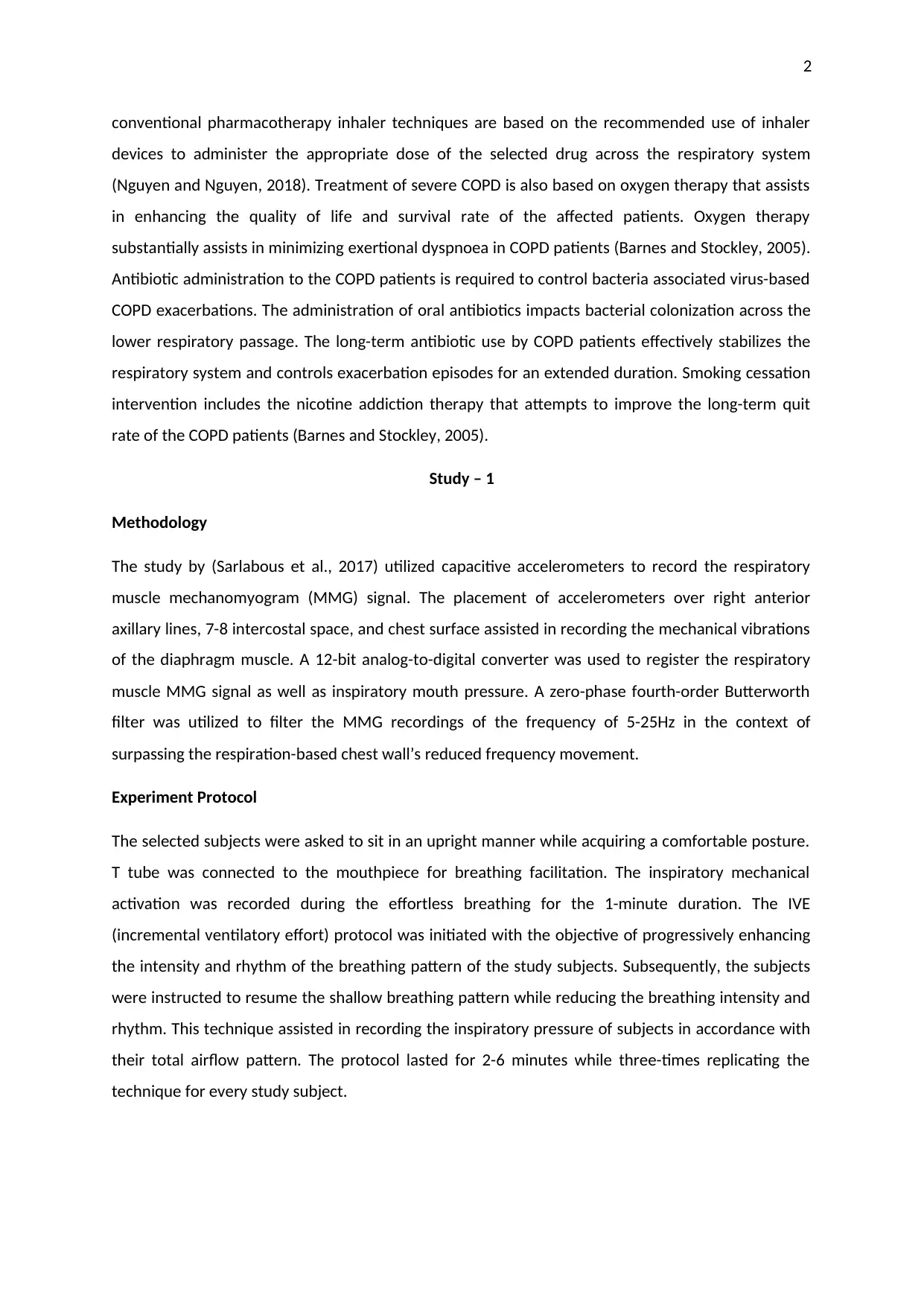
2
conventional pharmacotherapy inhaler techniques are based on the recommended use of inhaler
devices to administer the appropriate dose of the selected drug across the respiratory system
(Nguyen and Nguyen, 2018). Treatment of severe COPD is also based on oxygen therapy that assists
in enhancing the quality of life and survival rate of the affected patients. Oxygen therapy
substantially assists in minimizing exertional dyspnoea in COPD patients (Barnes and Stockley, 2005).
Antibiotic administration to the COPD patients is required to control bacteria associated virus-based
COPD exacerbations. The administration of oral antibiotics impacts bacterial colonization across the
lower respiratory passage. The long-term antibiotic use by COPD patients effectively stabilizes the
respiratory system and controls exacerbation episodes for an extended duration. Smoking cessation
intervention includes the nicotine addiction therapy that attempts to improve the long-term quit
rate of the COPD patients (Barnes and Stockley, 2005).
Study – 1
Methodology
The study by (Sarlabous et al., 2017) utilized capacitive accelerometers to record the respiratory
muscle mechanomyogram (MMG) signal. The placement of accelerometers over right anterior
axillary lines, 7-8 intercostal space, and chest surface assisted in recording the mechanical vibrations
of the diaphragm muscle. A 12-bit analog-to-digital converter was used to register the respiratory
muscle MMG signal as well as inspiratory mouth pressure. A zero-phase fourth-order Butterworth
filter was utilized to filter the MMG recordings of the frequency of 5-25Hz in the context of
surpassing the respiration-based chest wall’s reduced frequency movement.
Experiment Protocol
The selected subjects were asked to sit in an upright manner while acquiring a comfortable posture.
T tube was connected to the mouthpiece for breathing facilitation. The inspiratory mechanical
activation was recorded during the effortless breathing for the 1-minute duration. The IVE
(incremental ventilatory effort) protocol was initiated with the objective of progressively enhancing
the intensity and rhythm of the breathing pattern of the study subjects. Subsequently, the subjects
were instructed to resume the shallow breathing pattern while reducing the breathing intensity and
rhythm. This technique assisted in recording the inspiratory pressure of subjects in accordance with
their total airflow pattern. The protocol lasted for 2-6 minutes while three-times replicating the
technique for every study subject.
conventional pharmacotherapy inhaler techniques are based on the recommended use of inhaler
devices to administer the appropriate dose of the selected drug across the respiratory system
(Nguyen and Nguyen, 2018). Treatment of severe COPD is also based on oxygen therapy that assists
in enhancing the quality of life and survival rate of the affected patients. Oxygen therapy
substantially assists in minimizing exertional dyspnoea in COPD patients (Barnes and Stockley, 2005).
Antibiotic administration to the COPD patients is required to control bacteria associated virus-based
COPD exacerbations. The administration of oral antibiotics impacts bacterial colonization across the
lower respiratory passage. The long-term antibiotic use by COPD patients effectively stabilizes the
respiratory system and controls exacerbation episodes for an extended duration. Smoking cessation
intervention includes the nicotine addiction therapy that attempts to improve the long-term quit
rate of the COPD patients (Barnes and Stockley, 2005).
Study – 1
Methodology
The study by (Sarlabous et al., 2017) utilized capacitive accelerometers to record the respiratory
muscle mechanomyogram (MMG) signal. The placement of accelerometers over right anterior
axillary lines, 7-8 intercostal space, and chest surface assisted in recording the mechanical vibrations
of the diaphragm muscle. A 12-bit analog-to-digital converter was used to register the respiratory
muscle MMG signal as well as inspiratory mouth pressure. A zero-phase fourth-order Butterworth
filter was utilized to filter the MMG recordings of the frequency of 5-25Hz in the context of
surpassing the respiration-based chest wall’s reduced frequency movement.
Experiment Protocol
The selected subjects were asked to sit in an upright manner while acquiring a comfortable posture.
T tube was connected to the mouthpiece for breathing facilitation. The inspiratory mechanical
activation was recorded during the effortless breathing for the 1-minute duration. The IVE
(incremental ventilatory effort) protocol was initiated with the objective of progressively enhancing
the intensity and rhythm of the breathing pattern of the study subjects. Subsequently, the subjects
were instructed to resume the shallow breathing pattern while reducing the breathing intensity and
rhythm. This technique assisted in recording the inspiratory pressure of subjects in accordance with
their total airflow pattern. The protocol lasted for 2-6 minutes while three-times replicating the
technique for every study subject.

3
Sampling
The study engaged seven healthy subjects and thirteen patients affected by COPD. Healthy subjects
included four males and three female individuals. However, diseased subjects included eleven male
and two female patients.
Data Analysis
MLZ (Multistate Lempel-Ziv) index was utilized to record the inspiratory muscles’ mechanical
strength. The assessment of non-occluded tidal volume-based peak inspiratory mouth pressure
helped in tracking the inspiratory muscles’ mechanical outcome during a complete respiratory cycle.
This assisted in evaluating the overall distensibility and activity of the respiratory muscle. The MMG
indices/peak inspiratory mouth pressure’s median value recording assisted in evaluating the
mechanical activation pattern and inspiratory muscle effort of the selected subjects. The MMG-
based inspiratory muscle activity was eventually compared with the inspiratory muscle potential
obtained through the conventional RMS (root mean square) method. Pearson correlation coefficient
and Wilcoxon signed-rank test were used to comparatively analyze the inspiratory muscle capacity
of healthy groups and COPD patients.
Results
The study outcomes revealed the elevated value of mean respiratory frequency in COPD patients as
compared to the healthy subjects. Ventilation level enhancement significantly increased the MMG-
RMS, MMG-MLZ, and peak inspiratory mouth pressures in COPD groups as compared to the healthy
subjects. The mean and peak tidal volume and inspiratory mouth pressure assisted in identifying the
inspiration-based muscle effort, respiratory components, and respiratory system compliance of the
study groups. The assessment of synergistic respiratory muscle action was undertaken through the
evaluation of inspiratory mouth pressure of the study candidates. The study revealed an inverse
relationship between respiratory muscle activation and COPD severity.
Study – 2
Methodology
The study by (Torres et al., 2010) instrumented the subjects with the objective of acquiring the right
and left hemidiaphragm mechanomyometric signals (MMGr and MMGl) along with the (IP)
inspiratory pressure. The pressure transducer was utilized and placed across the subjects’ breathing
tube for the IP assessment. The thoracic cage was used to place Kistler 8312B2 capacitive
accelerometers in the context of retrieving MMGr and MMGl levels. Bilateral hemidiaphragm MMG
Sampling
The study engaged seven healthy subjects and thirteen patients affected by COPD. Healthy subjects
included four males and three female individuals. However, diseased subjects included eleven male
and two female patients.
Data Analysis
MLZ (Multistate Lempel-Ziv) index was utilized to record the inspiratory muscles’ mechanical
strength. The assessment of non-occluded tidal volume-based peak inspiratory mouth pressure
helped in tracking the inspiratory muscles’ mechanical outcome during a complete respiratory cycle.
This assisted in evaluating the overall distensibility and activity of the respiratory muscle. The MMG
indices/peak inspiratory mouth pressure’s median value recording assisted in evaluating the
mechanical activation pattern and inspiratory muscle effort of the selected subjects. The MMG-
based inspiratory muscle activity was eventually compared with the inspiratory muscle potential
obtained through the conventional RMS (root mean square) method. Pearson correlation coefficient
and Wilcoxon signed-rank test were used to comparatively analyze the inspiratory muscle capacity
of healthy groups and COPD patients.
Results
The study outcomes revealed the elevated value of mean respiratory frequency in COPD patients as
compared to the healthy subjects. Ventilation level enhancement significantly increased the MMG-
RMS, MMG-MLZ, and peak inspiratory mouth pressures in COPD groups as compared to the healthy
subjects. The mean and peak tidal volume and inspiratory mouth pressure assisted in identifying the
inspiration-based muscle effort, respiratory components, and respiratory system compliance of the
study groups. The assessment of synergistic respiratory muscle action was undertaken through the
evaluation of inspiratory mouth pressure of the study candidates. The study revealed an inverse
relationship between respiratory muscle activation and COPD severity.
Study – 2
Methodology
The study by (Torres et al., 2010) instrumented the subjects with the objective of acquiring the right
and left hemidiaphragm mechanomyometric signals (MMGr and MMGl) along with the (IP)
inspiratory pressure. The pressure transducer was utilized and placed across the subjects’ breathing
tube for the IP assessment. The thoracic cage was used to place Kistler 8312B2 capacitive
accelerometers in the context of retrieving MMGr and MMGl levels. Bilateral hemidiaphragm MMG
⊘ This is a preview!⊘
Do you want full access?
Subscribe today to unlock all pages.

Trusted by 1+ million students worldwide
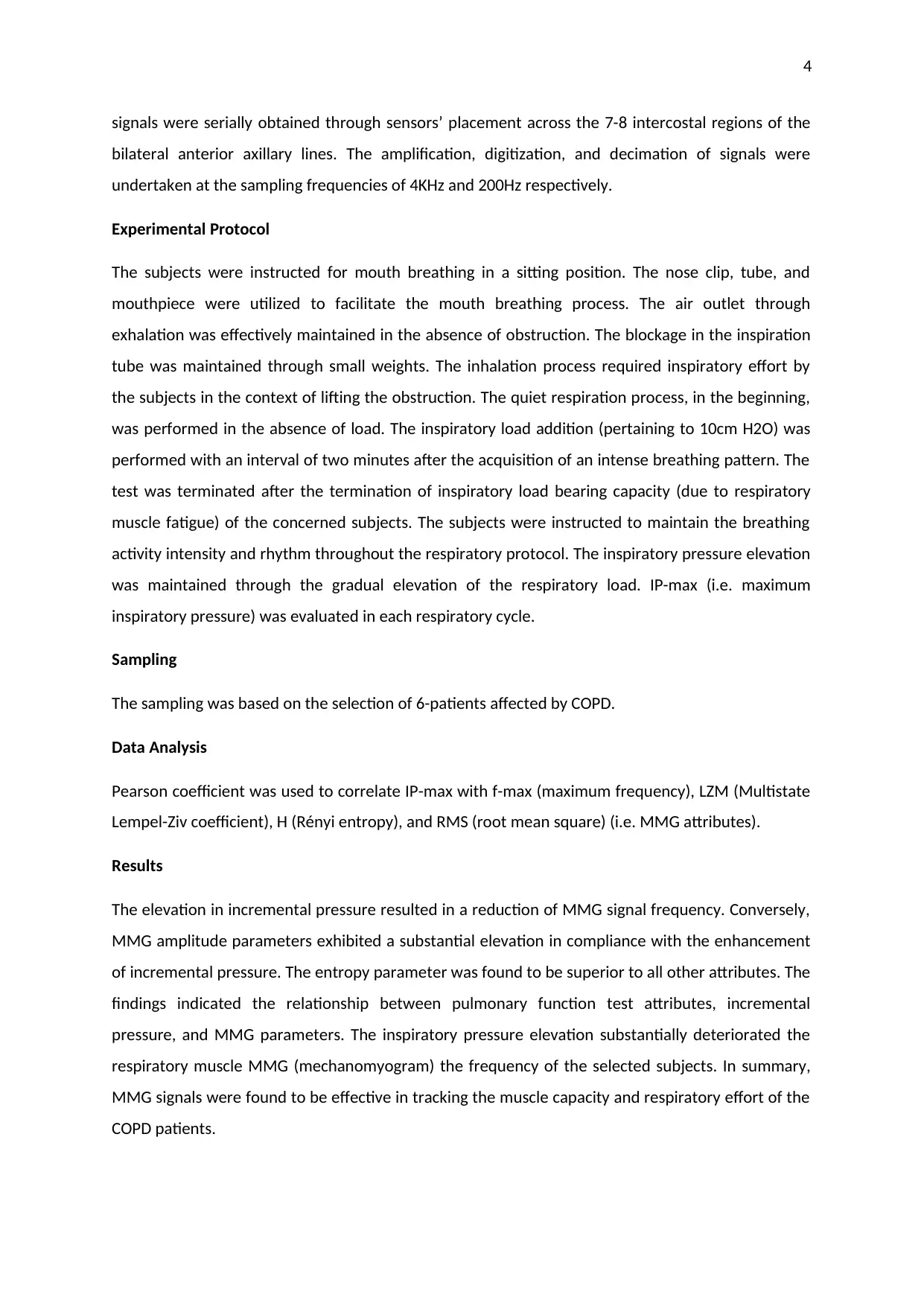
4
signals were serially obtained through sensors’ placement across the 7-8 intercostal regions of the
bilateral anterior axillary lines. The amplification, digitization, and decimation of signals were
undertaken at the sampling frequencies of 4KHz and 200Hz respectively.
Experimental Protocol
The subjects were instructed for mouth breathing in a sitting position. The nose clip, tube, and
mouthpiece were utilized to facilitate the mouth breathing process. The air outlet through
exhalation was effectively maintained in the absence of obstruction. The blockage in the inspiration
tube was maintained through small weights. The inhalation process required inspiratory effort by
the subjects in the context of lifting the obstruction. The quiet respiration process, in the beginning,
was performed in the absence of load. The inspiratory load addition (pertaining to 10cm H2O) was
performed with an interval of two minutes after the acquisition of an intense breathing pattern. The
test was terminated after the termination of inspiratory load bearing capacity (due to respiratory
muscle fatigue) of the concerned subjects. The subjects were instructed to maintain the breathing
activity intensity and rhythm throughout the respiratory protocol. The inspiratory pressure elevation
was maintained through the gradual elevation of the respiratory load. IP-max (i.e. maximum
inspiratory pressure) was evaluated in each respiratory cycle.
Sampling
The sampling was based on the selection of 6-patients affected by COPD.
Data Analysis
Pearson coefficient was used to correlate IP-max with f-max (maximum frequency), LZM (Multistate
Lempel-Ziv coefficient), H (Rényi entropy), and RMS (root mean square) (i.e. MMG attributes).
Results
The elevation in incremental pressure resulted in a reduction of MMG signal frequency. Conversely,
MMG amplitude parameters exhibited a substantial elevation in compliance with the enhancement
of incremental pressure. The entropy parameter was found to be superior to all other attributes. The
findings indicated the relationship between pulmonary function test attributes, incremental
pressure, and MMG parameters. The inspiratory pressure elevation substantially deteriorated the
respiratory muscle MMG (mechanomyogram) the frequency of the selected subjects. In summary,
MMG signals were found to be effective in tracking the muscle capacity and respiratory effort of the
COPD patients.
signals were serially obtained through sensors’ placement across the 7-8 intercostal regions of the
bilateral anterior axillary lines. The amplification, digitization, and decimation of signals were
undertaken at the sampling frequencies of 4KHz and 200Hz respectively.
Experimental Protocol
The subjects were instructed for mouth breathing in a sitting position. The nose clip, tube, and
mouthpiece were utilized to facilitate the mouth breathing process. The air outlet through
exhalation was effectively maintained in the absence of obstruction. The blockage in the inspiration
tube was maintained through small weights. The inhalation process required inspiratory effort by
the subjects in the context of lifting the obstruction. The quiet respiration process, in the beginning,
was performed in the absence of load. The inspiratory load addition (pertaining to 10cm H2O) was
performed with an interval of two minutes after the acquisition of an intense breathing pattern. The
test was terminated after the termination of inspiratory load bearing capacity (due to respiratory
muscle fatigue) of the concerned subjects. The subjects were instructed to maintain the breathing
activity intensity and rhythm throughout the respiratory protocol. The inspiratory pressure elevation
was maintained through the gradual elevation of the respiratory load. IP-max (i.e. maximum
inspiratory pressure) was evaluated in each respiratory cycle.
Sampling
The sampling was based on the selection of 6-patients affected by COPD.
Data Analysis
Pearson coefficient was used to correlate IP-max with f-max (maximum frequency), LZM (Multistate
Lempel-Ziv coefficient), H (Rényi entropy), and RMS (root mean square) (i.e. MMG attributes).
Results
The elevation in incremental pressure resulted in a reduction of MMG signal frequency. Conversely,
MMG amplitude parameters exhibited a substantial elevation in compliance with the enhancement
of incremental pressure. The entropy parameter was found to be superior to all other attributes. The
findings indicated the relationship between pulmonary function test attributes, incremental
pressure, and MMG parameters. The inspiratory pressure elevation substantially deteriorated the
respiratory muscle MMG (mechanomyogram) the frequency of the selected subjects. In summary,
MMG signals were found to be effective in tracking the muscle capacity and respiratory effort of the
COPD patients.
Paraphrase This Document
Need a fresh take? Get an instant paraphrase of this document with our AI Paraphraser

5
Study – 3
Methodology
The sternomastoid muscle was targeted for EMG (electromyography) through the utilization of a
portable EMG machine (Kanwade and Bairagi, 2016). The tedious and central muscle regions were
selected for electrode placement. The respiratory load was constantly provided before data
collection. The electrode centers were separated apart with 1-2cm distance.
Experimental Protocol
Patients’ demographic and spirometry data were evaluated for comparison with the standard
system. EMG assessment was performed to evaluate the number of peaks/turns, mean rectified
voltage, root mean square value, peak-to-peak value, and linear envelope in accordance with the
prespecified frequency and time domains. Lineal envelop indicated myoelectric activity and
contraction pattern of the sternomastoid muscle that required retrieval through the utilization of
20Hz low pass filter and full wave rectifier. Root mean square method was used to further evaluate
the muscle contraction pattern and associated behavior of the motor unit. The integration value of
the sternomastoid muscle reciprocated the action potential frequency and amplitude duration. The
enhancement of EMG zero-crossing value for reduced activity level Indicated increased muscle
function. Spike counting method indicated muscle activity at the reduced level of force. In summary,
EMG signals the physiological events of the selected sternomastoid muscle.
Sampling
The researchers selected four females and six male COPD subjects pertaining to the age group of 56-
20 years for their EMG evaluation of the sternomastoid muscle.
Data Analysis
Data analysis for performed by correlation coefficient to evaluate the relationship between
sternomastoid muscle activity, respiratory effort, and forced an expiratory volume of the selected
candidates.
Results
The results indicated a reciprocal relationship between sternomastoid muscle activity and EMG peak
voltage. Furthermore, the activity of sternomastoid muscle was based on respiratory effort
undertaken after a reported reduction in forced expiratory volume. The study outcomes also
Study – 3
Methodology
The sternomastoid muscle was targeted for EMG (electromyography) through the utilization of a
portable EMG machine (Kanwade and Bairagi, 2016). The tedious and central muscle regions were
selected for electrode placement. The respiratory load was constantly provided before data
collection. The electrode centers were separated apart with 1-2cm distance.
Experimental Protocol
Patients’ demographic and spirometry data were evaluated for comparison with the standard
system. EMG assessment was performed to evaluate the number of peaks/turns, mean rectified
voltage, root mean square value, peak-to-peak value, and linear envelope in accordance with the
prespecified frequency and time domains. Lineal envelop indicated myoelectric activity and
contraction pattern of the sternomastoid muscle that required retrieval through the utilization of
20Hz low pass filter and full wave rectifier. Root mean square method was used to further evaluate
the muscle contraction pattern and associated behavior of the motor unit. The integration value of
the sternomastoid muscle reciprocated the action potential frequency and amplitude duration. The
enhancement of EMG zero-crossing value for reduced activity level Indicated increased muscle
function. Spike counting method indicated muscle activity at the reduced level of force. In summary,
EMG signals the physiological events of the selected sternomastoid muscle.
Sampling
The researchers selected four females and six male COPD subjects pertaining to the age group of 56-
20 years for their EMG evaluation of the sternomastoid muscle.
Data Analysis
Data analysis for performed by correlation coefficient to evaluate the relationship between
sternomastoid muscle activity, respiratory effort, and forced an expiratory volume of the selected
candidates.
Results
The results indicated a reciprocal relationship between sternomastoid muscle activity and EMG peak
voltage. Furthermore, the activity of sternomastoid muscle was based on respiratory effort
undertaken after a reported reduction in forced expiratory volume. The study outcomes also
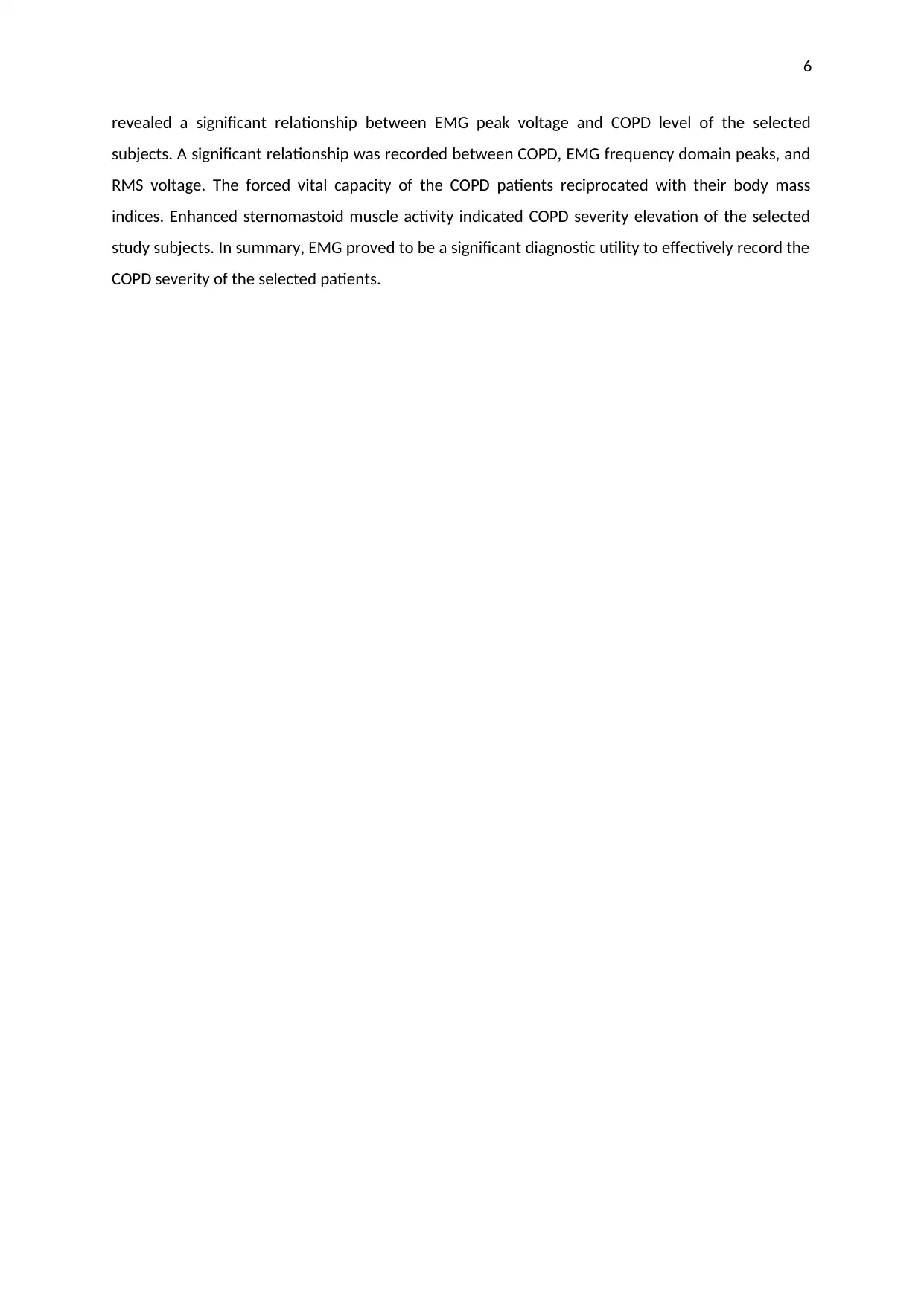
6
revealed a significant relationship between EMG peak voltage and COPD level of the selected
subjects. A significant relationship was recorded between COPD, EMG frequency domain peaks, and
RMS voltage. The forced vital capacity of the COPD patients reciprocated with their body mass
indices. Enhanced sternomastoid muscle activity indicated COPD severity elevation of the selected
study subjects. In summary, EMG proved to be a significant diagnostic utility to effectively record the
COPD severity of the selected patients.
revealed a significant relationship between EMG peak voltage and COPD level of the selected
subjects. A significant relationship was recorded between COPD, EMG frequency domain peaks, and
RMS voltage. The forced vital capacity of the COPD patients reciprocated with their body mass
indices. Enhanced sternomastoid muscle activity indicated COPD severity elevation of the selected
study subjects. In summary, EMG proved to be a significant diagnostic utility to effectively record the
COPD severity of the selected patients.
⊘ This is a preview!⊘
Do you want full access?
Subscribe today to unlock all pages.

Trusted by 1+ million students worldwide

7
References
Barnes, P.J. and Stockley, R.A. (2005) 'COPD: current therapeutic interventions and future
approaches', ERJ, pp. 1084-1106, Available: http://erj.ersjournals.com/content/25/6/1084.
Burkhardt, R. and Pankow, W. (2014) 'The Diagnosis of Chronic Obstructive Pulmonary
Disease', Dtsch Arztebl Int, vol. 111, no. 49, pp. 834-846, Available:
https://www.ncbi.nlm.nih.gov/pmc/articles/PMC4284520/#s8title.
Johns, D.P., Walters, J.A.E. and Walters, E.H. (2014) 'Diagnosis and early detection of
COPD using spirometry', Jour, vol. 6, no. 11, pp. 1557-1569, Available:
https://www.ncbi.nlm.nih.gov/pmc/articles/PMC4255165/.
Kanwade, A.B. and Bairagi, V. (2016) 'Analysis of Inspiratory Muscle', Advances in Signal
Processing and Intelligent Recognition Systems, pp. 357-366.
Leupoldt, A.V., Fritzsche, A., Trueba, A.F., Meuret, A.E. and Ritz, T. (2012) 'Behavioral
Medicine Approaches to Chronic Obstructive Pulmonary Disease', Ann Behav Med, vol. 44,
no. 1, pp. 52-65, Available: https://www.ncbi.nlm.nih.gov/pmc/articles/PMC3612952/.
Montuschi, P. (2006) 'Pharmacological treatment of chronic obstructive pulmonary disease',
Int J Chron Obstruct Pulmon Dis, vol. 1, no. 4, pp. 409–423, Available:
https://www.ncbi.nlm.nih.gov/pmc/articles/PMC2707800/.
Nguyen, T.S. and Nguyen, T.L.H. (2018) 'Pharmacists' training to improve inhaler technique
of patients with COPD in Vietnam', Dovepress, March, pp. 1863-1872, Available:
https://www.dovepress.com/pharmacists-training-to-improve-inhaler-technique-of-patients-
with-cop-peer-reviewed-article-COPD.
Sarlabous, L., Torres, A., Fiz, J.A., MartõÂnez-Llorens, J.M., Gea, J. and Jane, R. (2017)
'Inspiratory muscle activation increases with COPD severity as confirmed by non-invasive
mechanomyographic analysis', PLoS One, May, pp. 1-14.
Torres, A., Sarlabous , L., Fiz , J.A., Gea , J., Martinez-Llorens , J.M., Morera, J. and Jane, R.
(2010) 'Noninvasive Measurement of Inspiratory Muscle Performance by means of
Diaphragm Muscle Mechanomyographic Signals in COPD patients during an Incremental
References
Barnes, P.J. and Stockley, R.A. (2005) 'COPD: current therapeutic interventions and future
approaches', ERJ, pp. 1084-1106, Available: http://erj.ersjournals.com/content/25/6/1084.
Burkhardt, R. and Pankow, W. (2014) 'The Diagnosis of Chronic Obstructive Pulmonary
Disease', Dtsch Arztebl Int, vol. 111, no. 49, pp. 834-846, Available:
https://www.ncbi.nlm.nih.gov/pmc/articles/PMC4284520/#s8title.
Johns, D.P., Walters, J.A.E. and Walters, E.H. (2014) 'Diagnosis and early detection of
COPD using spirometry', Jour, vol. 6, no. 11, pp. 1557-1569, Available:
https://www.ncbi.nlm.nih.gov/pmc/articles/PMC4255165/.
Kanwade, A.B. and Bairagi, V. (2016) 'Analysis of Inspiratory Muscle', Advances in Signal
Processing and Intelligent Recognition Systems, pp. 357-366.
Leupoldt, A.V., Fritzsche, A., Trueba, A.F., Meuret, A.E. and Ritz, T. (2012) 'Behavioral
Medicine Approaches to Chronic Obstructive Pulmonary Disease', Ann Behav Med, vol. 44,
no. 1, pp. 52-65, Available: https://www.ncbi.nlm.nih.gov/pmc/articles/PMC3612952/.
Montuschi, P. (2006) 'Pharmacological treatment of chronic obstructive pulmonary disease',
Int J Chron Obstruct Pulmon Dis, vol. 1, no. 4, pp. 409–423, Available:
https://www.ncbi.nlm.nih.gov/pmc/articles/PMC2707800/.
Nguyen, T.S. and Nguyen, T.L.H. (2018) 'Pharmacists' training to improve inhaler technique
of patients with COPD in Vietnam', Dovepress, March, pp. 1863-1872, Available:
https://www.dovepress.com/pharmacists-training-to-improve-inhaler-technique-of-patients-
with-cop-peer-reviewed-article-COPD.
Sarlabous, L., Torres, A., Fiz, J.A., MartõÂnez-Llorens, J.M., Gea, J. and Jane, R. (2017)
'Inspiratory muscle activation increases with COPD severity as confirmed by non-invasive
mechanomyographic analysis', PLoS One, May, pp. 1-14.
Torres, A., Sarlabous , L., Fiz , J.A., Gea , J., Martinez-Llorens , J.M., Morera, J. and Jane, R.
(2010) 'Noninvasive Measurement of Inspiratory Muscle Performance by means of
Diaphragm Muscle Mechanomyographic Signals in COPD patients during an Incremental
Paraphrase This Document
Need a fresh take? Get an instant paraphrase of this document with our AI Paraphraser
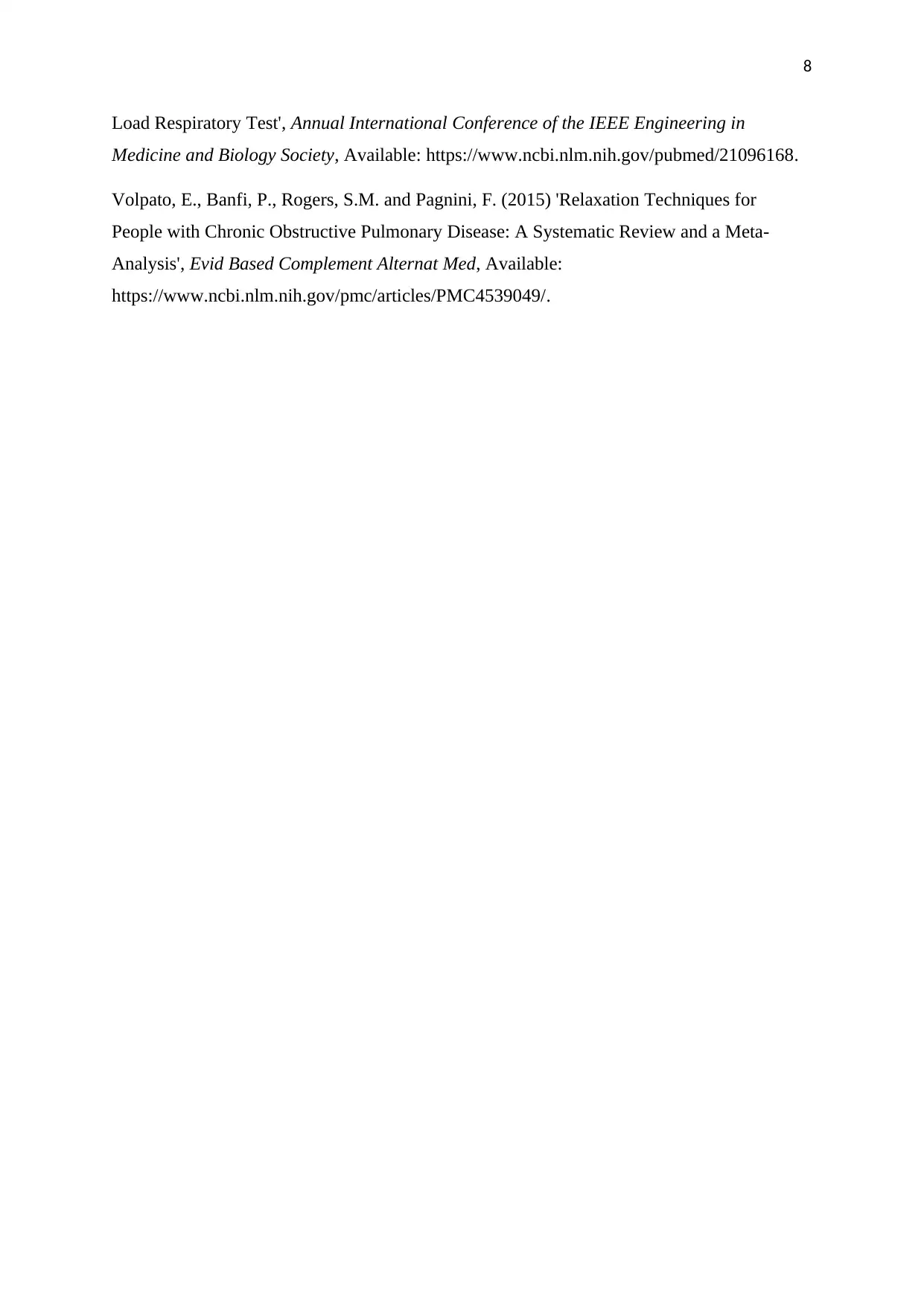
8
Load Respiratory Test', Annual International Conference of the IEEE Engineering in
Medicine and Biology Society, Available: https://www.ncbi.nlm.nih.gov/pubmed/21096168.
Volpato, E., Banfi, P., Rogers, S.M. and Pagnini, F. (2015) 'Relaxation Techniques for
People with Chronic Obstructive Pulmonary Disease: A Systematic Review and a Meta-
Analysis', Evid Based Complement Alternat Med, Available:
https://www.ncbi.nlm.nih.gov/pmc/articles/PMC4539049/.
Load Respiratory Test', Annual International Conference of the IEEE Engineering in
Medicine and Biology Society, Available: https://www.ncbi.nlm.nih.gov/pubmed/21096168.
Volpato, E., Banfi, P., Rogers, S.M. and Pagnini, F. (2015) 'Relaxation Techniques for
People with Chronic Obstructive Pulmonary Disease: A Systematic Review and a Meta-
Analysis', Evid Based Complement Alternat Med, Available:
https://www.ncbi.nlm.nih.gov/pmc/articles/PMC4539049/.
1 out of 8
Related Documents
Your All-in-One AI-Powered Toolkit for Academic Success.
+13062052269
info@desklib.com
Available 24*7 on WhatsApp / Email
![[object Object]](/_next/static/media/star-bottom.7253800d.svg)
Unlock your academic potential
Copyright © 2020–2026 A2Z Services. All Rights Reserved. Developed and managed by ZUCOL.





